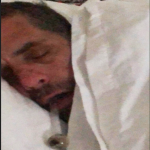Yes -- This is the study. There was some strange way they had of reporting the results though. It appears to say that 52% of the phones had S aureus but it also appeared to say that every strain of S aureus found was methicillin resistant which is unlikely. It also said that only about 40% of the phones had pathogenic bacteria, so how 52% could be found to have MRSA is beyond me. Even if it is 52% of the 40% the results are odd. Somewhere else I found data from the study that said 7 of the phones had "multi-drug resistant pathogens such as MRSA" (and none belonged to hospital staff.) And that 1 in 8 (12.5%) of the total sample actually had MRSA. In any case, it was quite unclear as they had multiple ways of reporting the data and I can see where someone would read this as over 50% MRSA, but I think it was an error in reporting the statistics -- unless MRSA is far more prevalent in Turkey than it is in the USA which is entirely possible. Many strange numbers from the same study!SleepyonMagnoliaSt wrote:Kate M wrote:Can you supply a source for this number? I find the percentage shockingly high. A study that I saw found ~ 12.5% cell phones collected in a Turkish hospital from patients, visitors and staff had MRSA. This has been considered a frighteningly high number. Your number is 4x that! I would love to know what the source of it is.SleepyonMagnoliaSt wrote:especially since studies show that 50% of people with cellphone have MRSA ON their cellphones. Meaning you can breathe that in very easily.
Thanks!
Kate
'The study was led by Mehmet Sait Tekerekoglu, MD, of the Department of Medical Microbiology at Inonu University in Malatya.
The researchers took swab samples from 133 mobile phones they obtained from patients, patients, companions, and visitors and 67 from healthcare workers, and ran cultures on bacteria collected from the keypads, microphones and ear parts of each device.
Nearly 40% of the phones collected from patients and their visitors, versus 20.6% of those collected from healthcare workers, showed presence of pathogenic bacteria. "Furthermore (a) higher number of multi-drug resistant pathogens were present on the mobile phones of (the) patients' group (including family members and patients' companions)."'
http://www.healthleadersmedia.com/page- ... rchers-Say##
But I am sure that 50% is far too high a number.















